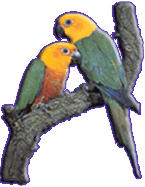|
|
| |
|
|
|
|
CRIMSON ROSELLA
Platycercus Elegans |
|
|
| |
|
This species originally comes from eastern and southern regions of Australia . Crimson Rosella, also known as Penant is the only rosella species that lives in forests. All other rosella live in savannahs or steppes. Forest humidity affects the intensity of the red coloration. There are two subspecies: Platycercus Nigresceus and Platycercus Melanoptera. The first one is native to the northern tropical regions. Their youngsters leave the nest with bright-red feathers, while the youngsters of the second subspecies, Platycercus Elegans (it is the same for all other subspecies), and leave their nests with more green then red coloration. These chicks get their adult coloration when they become mature. Their wings, laterals, crop and tail brims are blue, while the back is similar to Eastern Rosella , which is a scale of red and black. The legs are grayish black and the beak is white with black end. |
|
|
Penant is around 36 cm long, and the difference between sexes is only in size. Female has smaller head and narrow back. On her skull there is a characteristically bulge on the jawbone. This species does not mind the cold; they can survive on 2000 m height during winter and snow. In the wild, they feed mostly on the seeds of eucalyptus tree and other seeds, off course insects and local fruit and vegetables.
|
|
|
|
|
They mate in the early spring. Female lays 4 to 7 cream eggs in deep trunks or stumps. The eggs are creamy white, sized 25x30. The incubation period is around 33 days. The youngsters leave the nest 5 weeks after hatching but stay with the parents for one more month. Juveniles are green with few red feathers on the breasts and belly. They mature after 13 to 15 months. Week and skinny chicks get the red color in the nest; the strong and good fed ones leave the nest green. Some Rosella, even though not matured, they get their adult color in the first year. Rosella mature in the age of two. Crimson Rosella exceptionally rear two broods in a year.
|
|
|
|
pair of penant in the mating period
(female stands on the nest while the male is strutting around) |
|
| |
In captivity, penant should eat seeds of sunflower, oat, proso, bright seed, canary seed, peas and vetch with required mineral and vitamin complex. They enjoy in fruit and vegetables. When giving them fresh food, chop it on a bit bigger peaces, because Penant is using legs while eating. It is very interesting that they adore rowanberries and snowberries, so I recommend apple, spinach, carrots, cucumber, paprika, parsley etc...
They look impressive with their beautiful red and blue feathers and their gracious walk and holding. They have soft call, not very loud, except for the mating period, when males become quarrelsome. They can live long and they are curious. I thing I gave you enough reasons to have one of these as your feathery friend. |
| |
|
|
| |
|
|
| |
|
|
|
| |
|
|
|
|
|

